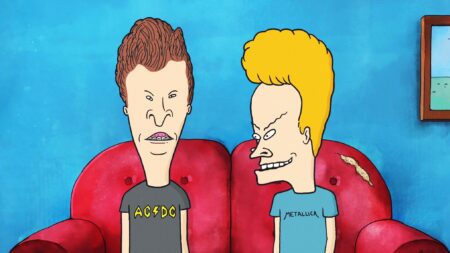The Lasting Legacy of MTV’s ‘Liquid Television,’ The Show That Launched Mike Judge, ‘Aeon Flux,’ & More

In 1991, MTV was a juggernaut of cable television, still firmly in its music video era but beginning to experiment with original content. This was before the rise of reality TV, when shows like The Real World and Road Rules would eventually set the template for what was possible, and eventually take over the network.
At the time, much of MTV’s programming felt experimental. Colin Quinn and Ken Ober had recently concluded their roles as hosts of the network’s first game show, Remote Control, while The Ben Stiller Show had premiered the previous year, featuring a then-emerging cast that included Andy Dick, Janeane Garofalo, and Bob Odenkirk. Meanwhile, Liquid Television, an avant-garde animation anthology, was preparing to make its debut.
The series meshed animated features of several mediums, including stop-motion, traditional animation, puppet theater, and anime, to create a showcase of cartoons of different genres that highlighted different artists and styles. The series quickly acted at a platform for beginning animators looking to get their foot in the door, as well as would-be filmmakers hoping to make a name for themselves.

MTV/Courtesy Everett Collection
And it worked.
From the start, one of the segments that immediately captured MTV’s audience was Peter Chung’s Æon Flux. Sleek, sexy, and subversive, the anime-inspired cyberpunk series blended Expressionist-era visuals with a dystopian science-fiction setting. The result was a striking narrative centered on a scantily clad super spy who, during her run on Liquid Television, remained mostly silent as she repeatedly attempted to topple a totalitarian regime, only to be killed over and over for her efforts.
The popularity of the segment led to a spinoff series, in which the character, now voiced by Denise Poirier, continued her surreal and cerebral battles against her philosophical adversary and sometime lover, Trevor Goodchild. The franchise would eventually culminate in a 2005 live-action film adaptation starring Charlize Theron.

Another breakout talent from Liquid Television was Mike Judge, who brought two of his animated shorts from the festival circuit to the series. One was a crude cartoon titled “Frog Baseball,” featuring two unnamed hooligans who amused themselves by tormenting amphibians—a concept that would eventually evolve into the MTV pop culture phenomenon Beavis and Butt-Head.
In the show’s second season, another Judge creation, “Office Space,” was featured. The short followed a disgruntled animated office worker named Milton who threatens to burn down his workplace. This character would later inspire the cult-classic film Office Space, directed by Judge and starring Ron Livingston and Jennifer Aniston.
Other animators who would go on to leave their mark on the cultural zeitgeist also got their start on Liquid Television. Joe Horne contributed a retro-futuristic segment called “The Specialists,” which followed a trio of stylish super agents. He later directed episodes of The Boondocks and lent his talents to animated series such as Teen Titans. Yoshiaki Kawajiri, who created the segment “The Running Man,” went on to make an indelible mark on anime by directing Vampire Hunter D: Bloodlust, The Animatrix, and Highlander: The Search for Vengeance, among others.

MTV/Courtesy Everett Collection
And let’s not forget the theme song, written by Mark Mothersbaugh, best known as the frontman for Devo. He had previously composed the music for Pee-wee’s Playhouse and would later go on to create theme and title songs for Rugrats, Dawson’s Creek, Yo Gabba Gabba!, Regular Show, Our Flag Means Death, and many more.
Although it ran for only four seasons and produced just 27 episodes, Liquid Television left an enduring mark on pop culture through the boundaries it pushed and the talent it launched. Its influence can still be felt today in shows like Hulu’s King of the Hill and in Netflix’s Love, Death & Robots and Castlevania, both of which echo the experimental spirit, mature themes, and visual boldness that defined the original anthology series. Its alumni continue to shape the entertainment landscape — whether through groundbreaking animation, boundary-pushing storytelling, or iconic characters that began as sketches on MTV’s most daring platform.

